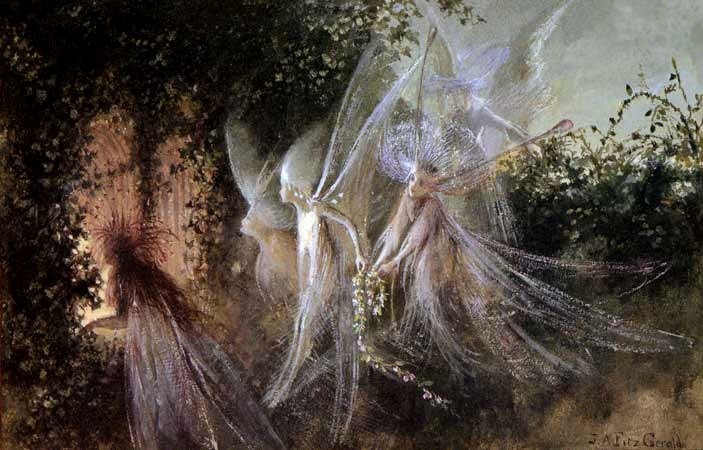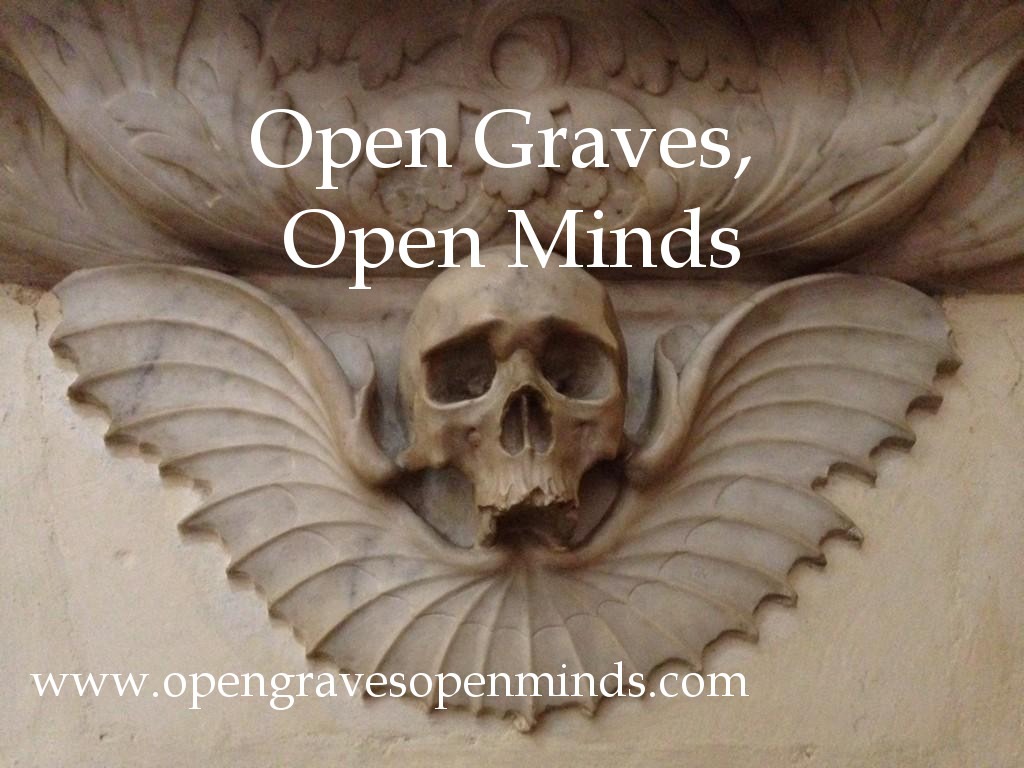
John Anster Fitzgerald (1823-1906), Fairies Looking Through a Gothic Arch
OGOM Online Conference 2021
‘Ill met by moonlight’: Gothic encounters with enchantment and the Faerie realm in literature and culture
University of Hertfordshire, 8‒11 April 2021
* You can now view the videos of the conference here; use the Programme to find out which day and room your chosen talks are in.
The full conference Programme is on line here. You can also download a specially designed, printable PDF of the official programme:
(Note: all times are in BST (GMT + 1). We are sorry for the inconvenience that may cause to some people–one of the disadvantages of an online event!)
You can also see a list of all the papers, expandable to show abstracts and author details.
Follow us on Twitter @OGOMProject #GothicFairies
This conference is uniquely situated at the intersection between folklore, fairy tale, and the Gothic. It celebrates the darker aspects of fairies and their kin and marks the centenary of the publication by Sir Arthur Conan Doyle of the infamous Cottingley Fairies photographs in the Strand Magazine (Dec 1920). It is broadly interdisciplinary, embracing literature, art, folklore, film, TV, photography, fashion, performance, gaming, and fairy fiction writing. We will journey into the history of the fae, exploring a diversity of media and genres: early modern burlesque poetry, Victorian fairy painting, fairies on stage, recent cinematic interpretations of the Cottingley Fairies; Paranormal Romance, steampunk, fairy fashion, the twenty-first-century fae of Young Adult Fiction and TV’s Carnival Row.
The Open Graves, Open Minds (OGOM) Project was launched in 2010 with the Vampires and the Undead in Modern Culture conference. We have subsequently hosted symposia on Bram Stoker and John William Polidori, unearthing depictions of the vampire in literature, art, and other media, before embracing shapeshifting creatures and other supernatural beings and their worlds. The Company of Wolves, our ground-breaking werewolf and feral humans conference, took place in 2015. This was followed by The Urban Weird, a folkloric collaboration with Supernatural Cities in 2017. The OGOM Project now extends to all narratives of the fantastic, the folkloric, the fabulous, and the magical.
Our research from these conferences and symposia has since been disseminated in various publications. We have produced two edited collections of essays: Open Graves, Open Minds: Representations of Vampires and the Undead from the Enlightenment to the Present Day (Manchester University Press, 2013) and In the Company of Wolves: Werewolves, Wolves, and Wild Children, ed. by Sam George and Bill Hughes (Manchester University Press, 2020) and two special issues of Gothic Studies: Vampires and the Undead in Modern Culture special issue, 15.1 (May 2013) and Werewolves and Wildness special issue, 21.1 (Spring 2019).
To celebrate the tenth anniversary of OGOM, we turn our attention to fairies and other creatures from the realm of Faerie, inviting talks on all aspects of Gothic Faerie (including global variants).
Gothic Faerie
As Prof. Dale Townsend has observed, the concept of the Gothic has had an association with fairies from its inception; even before Walpole’s 1764 Castle of Otranto (considered the first Gothic novel), eighteenth-century poetics talked of ‘the fairy kind of writing’ which, for Addison, ‘raise a pleasing kind of Horrour in the Mind of the Reader’ and ‘and favour those secret Terrours and Apprehensions to which the Mind of Man is naturally subject’. Johnson, in his Preface to Shakespeare (1765), talks of ‘the loves of Theseus and Hippolyta combined with the Gothic mythology of fairies’. ‘Horror’ and ‘terror’ are key terms of affect in Gothic criticism; Townsend urges us, however, to move away from this dichotomy. While we are certainly interested in the darker aspects of fairies and the fear they may induce, this conference also welcomes attention to that aspect of Gothic that invokes wonder and enchantment.
Fairies in folklore, unlike the prettified creatures we are familiar with, are always rather dangerous. Old ballads such as ‘Tam Lyn’ and ‘The Demon Lover’ reveal their unsettling side. The darker aspects of fairies and their kin may be glimpsed in the early modern work of Michael Drayton, Edmund Spenser, Robert Herrick, and, of course, Shakespeare. They have found their way into the Romanticism of Keats and Shelley, modulated by the Gothic. Fairies blossomed in the art and literature of the Victorians; though it is here perhaps that they are most sentimentalised, there is also much darkness. The paintings of Richard Dadd and John Anster Fitzgerald are tinged with Gothic as are classic works of fairy literature such as Christina Rossetti’s Goblin Market and J. M. Barrie’s Peter Pan. The nineteenth century also saw a surge in the dramatisation of fairies with the féerie (or ‘fairy play’), which set the scene for fairy ballets such as Les Sylphides as well as cinematic productions. Following the rise of the vampire lover in contemporary paranormal romance, dark fairies (alongside pixies, trolls, and similar creatures from the world of Faerie) have also been found in the arms and beds of humans. The original menace of traditional Faerie has been restored in the form of ambivalently sinister love objects. This has emerged from precursors such as Hope Mirrlees’s Lud-in-the-Mist (1926), Sylvia Townsend Warner’s Kingdoms of Elfin tales from the 1970s and the pioneering urban fantasy of Emma Bull’s War for the Oaks (1987), to more recent works like Neil Gaiman’s Stardust (1997) and Elizabeth Hand’s Mortal Love (2004). Young Adult writers such as Holly Black, Maggie Stiefvater, Julie Kagawa, Melissa Marr have all written fairy romances with more than a tinge of Gothic darkness and there are excellent adult paranormal fairy romances such as Jeanette Ng’s Under the Pendulum Sun (2017). Gothic Faery has manifested in other media: Gaiman’s Stardust has been filmed; cinematic interpretations of the phenomenon of the Cottingley Fairies have been made (with Photographing Fairies giving it a Gothic twist), and, recently, the dark fairies of Carnival Row have appeared on TV.
Max Weber and, subsequently, the Frankfurt School discerned a state of disenchantment in modernity, whereby industrialisation and instrumental rationality had erased the sense of the sacred in life with ambiguous effects. The appeal of fairy narratives in the modern era may be their power to re-enchant our desacralised world. Fairy narratives in the alienated world of modernity often represent untamed nature and lead us to explore environmental concerns. The Land of Faerie, Tir na Nog, the Otherworld can be a setting for Utopia. These tales may also uncover the repressed desires of inner nature, emancipatory yearnings, the spirit of revolution, creative inspiration, pure chaos, or Otherness in general. Yet often this is ambivalent; the Gothic darkness of enchantment may evoke a hesitancy over surrendering to nature or the irrational as well as having a restorative allure.
Keynotes and activities
The conference boasts eight keynotes, including Prof. Owen Davies, President of the Folklore Society and Dr Merrick Burrow, Curator of the forthcoming Cottingley Fairies Exhibition (Brotherton Library). We also have Dr Sam George (Associate Professor of Research, University of Hertfordshire) on ‘Fairy Lepidoptera’; Prof. Diane Purkiss (Keble College, Oxford), ‘Where Do Fairies Come From?; Prof. Catherine Spooner (Lancaster University), ‘Glamourie: Fairies and Fashion’; Prof. Dale Townshend (Manchester Metropolitan University), ‘The fairy kind of writing’: Dr Maisha Wester (Indiana University; Global Professorship Fellowship, University of Sheffield), ‘Nalo Hopkinson’s Folkloric Revisions of Classic Fairytales and Myths’; Dr Ivan Phillips, Associate Dean, School of Creative Arts, University of Hertfordshire, ‘What the Puck?’.
Delegates are invited to take part in a range of exciting fairy themed activities, including a wine and wings social, a fairy flash fiction writing competition, and workshops by YA fantasy writer Betsy Cornwell (Tides, Mechanica, Venturess) on the creative adaptation of fairy lore; and Dr Ceri Houlbrook (University of Hertfordshire; Magical Folk (2018)), on outreach in the field of folklore studies for postgraduate students and ECRs.
More details on the Plenaries and Activities can be found here.
Follow us on Twitter @OGOMProject #GothicFairies

